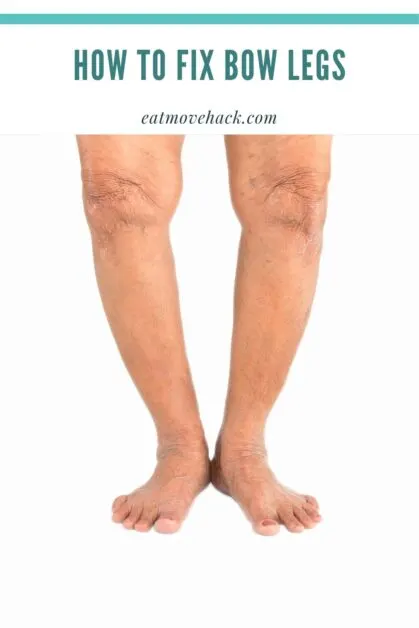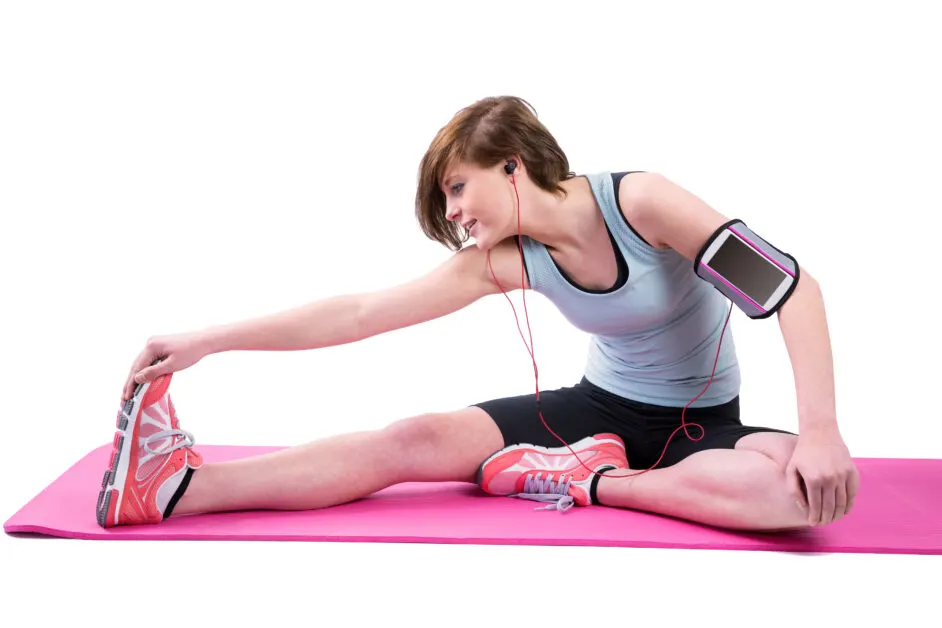Some of the links in this post are affiliate links. This means if you click on the link and purchase the item, we will receive an affiliate commission from the vendor at no extra cost to you. These business relationships allow us to keep bringing you great EatMoveHack content. All opinions remain our own.
It’s very common for a child’s legs to bow outward when they’re young. Called bow legs, this condition typically reverses once they start to walk. But what are you to do when this issue follows you into adulthood or develops later in life? Depending on the severity of your condition, your bow legs may not be very noticeable to those around you, but it can cause considerable pain when you walk and especially when you exercise.
Some instances of bow leg are caused by a bone deformity and can only be corrected through surgery. But if yours is a result of tight muscles from a vitamin deficiency or other cause, you may find relief by practicing bow leg straightening exercises for adults.

What is Bow Leg Syndrome?
The proper medical term for bow legs syndrome is genu varum, but the condition is also commonly known as bandy-leg, bowed legs, bowlegs, tibia vara, and varus deformity. When you suffer from this issue, your legs curve outward, creating a small or large gap between your knees.
Bow legs are common in infants and toddlers due to the position they are held in the womb. However, it often resolves itself naturally as a child grows and starts to walk, bearing weight on their legs.
When bow leg presents in an adult, it’s typically a result of Blount’s disease, bone fractures, irregular bone growth, fluoride or lead poisoning, nutritional deficiencies, or osteoarthritis.
Depending on the severity of your situation, you might suffer from minor inconveniences relating to minor pain and lack of balance or major issues with mobility. You may require no medical treatment at all, be prescribed a corrective brace, or be advised to undergo surgery.
Challenges of Living with Bow Legs
When your legs are bent outward, it puts excessive stress on various parts of your body, which can cause pain or even further injury.
Aching and Damaged Joints
Knee pain is a common complaint of those suffering from bow leg syndrome. It occurs because your knees are experiencing unbalanced loads; this can cause excessive stretching of the cartilage and make bones rub against each other. Other areas of the body that are often affected by bow legs include the hips, thighs, shins, and ankles.
You might notice some aches and pains when you complete everyday activities like walking or climbing stairs. But your knee, joint, and muscle pain may really flare up when you engage in high-impact exercises, like running and playing sports, due to the increased stress.
Continuing to engage in high-impact activities while suffering from bow leg can lead to permanent damage. You can tear ligaments, develop Achilles tendonitis, or even trigger osteoarthritis.
Balancing Issues
Those who suffer from genu varum also tend to be at increased risk of balancing issues due to the way your center of mass changes when you move. Balancing trouble can make it difficult to walk, climb stairs, or even stand.
7 Exercises to Help Straighten Bow Legs
Depending on the cause and severity of your bow legs, you may be able to practice exercises that can offer relief from the pain and restriction that comes from having bent legs. These types of exercises are called neuromuscular training, and they focus on stretching and strengthening the muscles around the knees, hips, and thighs to help with better alignment of the joints.
1. Hamstring Stretch

- Sit down on the floor.
- Stretch one leg out straight in front of you.
- Bend the other leg inward so that the arch of your foot is touching the outer portion of your other knee.
- Bend the ankle of your straightened leg forward, pointing your toes.
- Hold the position for one minute, and then relax.
- Reverse the positions of your legs, and repeat the exercise with your newly straightened leg.
- Repeat the exercise three times on each leg.
2. Groin Stretch
- Stand straight up with your legs spread wide.
- Shift your weight to your left side, bending your left knee until it’s hovering over your left foot.
- Ensure both feet are facing forward, and then hold the position for 30 seconds.
- Return to your original standing position.
- Switch sides, and perform the exercise on your other side by shifting your weight to the right and bending your right knee.
- Repeat the exercise three times on each side.
3. Piriformis Stretch
- Lie flat on your back on a hard or semi-hard surface.
- Keeping your shoulders flat, stretch your arms out to your sides until they’re level with your shoulders. Your body will resemble the letter T.
- Raise your right leg, and keeping it straight, bring it over your hips and left leg.
- Stretch your raised leg, bringing it to the ground as close as possible to your left hand. Do not lift your shoulders.
- Hold the position for 30 seconds, and then slowly return to your original position.
- Repeat the exercise with your other leg.
- Repeat the exercise 10 times with each leg.
4. Figure Four Stretch
- Lie flat on your back on a hard or semi-hard surface.
- Bend your knees, bringing them up until your feet are flat on the ground.
- Raise your left leg, bringing your foot up until it’s resting on your thigh just above your right knee.
- Raising your shoulders slightly, reach down and grasp your right thigh.
- Pull it toward you, lifting your right foot from the ground.
- Bring your shoulders and head back to the ground, continuing to pull your leg back.
- You’ll know you’re in the right position when you feel the stretch in your buttocks and thigh.
- Hold the position for 10 seconds, and then return to your original position.
- Repeat the exercise using the opposite leg.
- Repeat the exercise 5 times with each leg.
5. Rolled-Towel Toe Touch
- Roll up a bath towel width-wise, and keep it within reach. You may also use a foam roller if you have one.
- Stand straight up, with your feet a few inches apart.
- Position the rolled-up towel between your legs, and apply pressure with your thighs and knees to keep it in place.
- Keeping your legs straight, slowly bend forward to touch your toes. Bend as far as you can without pain or bending your legs.
- Slowly return to your starting position, and take a 10-second break.
- Repeat the exercise 10 times.
6. Toes-In Squat
- Stand straight up with your feet a few inches apart.
- Turn your feet inward until your big toes are touching. Your feet will resemble an arrow pointing forward.
- Slowly lower your body into a squat, going down as far as you can without pain. Note that your range of motion is limited with this exercise, so you may not be able to squat as low as usual.
- Hold the position for 10 seconds, and then slowly return to a standing position.
- Repeat the exercise 10 times.
7. Hip Internal Rotation
- Lie down on a hard or semi-hard surface.
- Roll your body to one side, with the side of your upper body flat on the ground and your leg resting on top of the other.
- Bend your knees backward about 90 degrees. Your body should now form a straight line from head to knees, with your lower legs and feet behind you.
- Ensuring your knees stay together, raise your top foot and lower leg several inches. This will naturally cause your hip to rotate inward.
- Repeat the exercise 10 times, and then roll to your other side to raise and lower the opposite leg.
FAQs
Do I have bow legs?
While the best way to have bowlegs diagnosed is to consult a doctor, there is a simple test you can perform that can give you some insight.
First, find a full-length mirror so that you examine yourself more easily. Stand up straight with your feet several inches from one another. Move one foot towards the other so that your feet and ankles touch.
As soon as your ankle comes in contact with your other ankle, your knees should also touch. If you notice a gap between your knees, you may be suffering from genu varum.
If you notice that your knees touch before you move your ankles together, you may be suffering from knock knees. Like bow legs, knock knees is common in childhood and typically resolves once a child starts to walk. However, you can develop it in adulthood as a result of arthritic conditions.
Do I need to fix my bow legs?
Only a doctor can advise you on the best course of action for your specific circumstances, but in most cases, you will want to have your bowlegs treated. If you ignore your condition, you are likely to develop pain and possibly damage your joints.
What options are there for fixing bow legs?
Physical therapy and practicing exercises that strengthen your leg, knee, and hip muscles could be an option for fixing your bow legs, depending on its cause and severity. Another option could be wearing corrective braces.
In those cases when bow legs are a result of a deformation of your leg bones, the best course of treatment may be surgery. Before making any decisions, seek professional medical advice from a doctor, physical therapist, or orthopedic surgeon for help with your specific situation.
Conclusion
There are several reasons you may develop bow legs as an adult. But no matter the cause, this isn’t a condition that you have to live with. If yours is caused by tight knee, thigh, or hip muscles, there are exercises you can perform to stretch and strengthen these areas. For many of these exercises, you won’t need any equipment at all, though a foam roller or resistance band can offer more of a challenge, while a yoga mat can make hard surfaces more comfortable.

